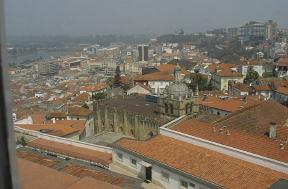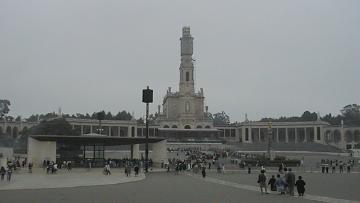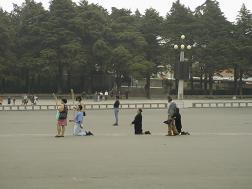
Coimbra
July 9th - July 11th, 1999

Chatting with folks in Porto led us to make a trip to inland Portugal to visit the university town of Coimbra. Important in Portugal's history as the educator of the majority of its kings and the notorious dictator (and former economics professor) Antònio Salazar, the university was founded in 1537. Unfortunately for us, inland Portugal roasts during the summer and we weren't able to follow the lead of the other tourists who had their own cars and made Coimbra a day trip from their cool seaside resorts.
The big attraction is the 18th century University Library built by King John V. Now a museum housing 300,000 volumes from the 12th to the 19th century, the detailing is incredible, with tables and shelves constructed of gilded rare woods. All the ceilings are immaculately painted, with a faux perspective that seems to raise the roof to the heavens. It really is breathtaking -- these photos don't do it justice.
|
|
|
Off the same square as the library is the University Chapel, built in 1517. Not as detailed as the wooden interiors we saw in Porto, the chapel is painted n a grand fashion. Near the chapel are a number of meeting rooms, within one of which we found this ancient set of arms with the abbreviation GRA on it. We joked that if a students admissions score fell too low, perhaps one of these beauties would be brought to bear.
|
|
The university also has a wonderful arboretum. Unfortunately for us, someone had abandoned a puppy there and he decided that we would make suitable new owners. We had a constant companion as we strolled through the gardens. Do you know how hard it is to ditch a puppy? It was heart-wrenching to give him the slip, but there was no place we could take him. In general, we found Portuguese attitudes about dogs a little scary; we saw a number of dog packs roaming the streets unattended.
|
|
Fatima
July 12th, 1999

On May 13th, 1917 three shepherd children said they spoke to the Virgin Mary. On the 13th of the following months, she reappeared to the children claiming that she would perform a miracle on her final appearance in October. Each month the crowds grew bigger, until on October 13th there were 70,000 people huddled underneath a torrential rain who claimed the sun spun around in the sky, sank to the earth and then reappeared with no evidence of a rainstorm at all. Suitably humbled, the people of Fatima built a chapel to honor Mary at that site (it's the small structure in the bottom left of the above photo).
Every 12th and 13th of the month thousands gather at the plaza in front of the chapel to pray to Mary and hope for their own miracles. Being in the neighborhood, we couldn't pass up this chance to witness holy fervor, so we hopped a train and spent a day in Fatima. The religious devotion of some is so great that they walk across the plaza (larger than the Vatican's) on their knees.

At night, a large outdoor mass is held in several languages, ending in a procession led by a lit cross and ending in the statue of Mary carried up to the front of the plaza. We saw over a 150 priests and bishops in attendance (seated, in the below right picture), but of the entire entourage the only females present were two altar girls and (of course) Mary herself. All around the plaza poor and handicapped people camped and huddled in fervent prayer.
|
 |
Although the Catholic church accepts the miracle of Fatima as given and well documented, no where did we find a photo or other hard evidence of the events of October 13th, 1917. Also, we found it a little odd that the miracle occurred in Fatima -- a town named after the daughter of Mohammed, the father of Islam and the last major prophet. All we do know is that Fatima today is the "Fisherman's Wharf" of religion, with store after store selling everything from religious trinkets to golden chalices.